IN THIS ISSUE
- Watch 'Longleaf Forever'
- Tortoise on the beach mystery
- In search of giant swallowtails
- A first for Alabama leatherflower
 Water, water, everywhere. Debby's slog through south Georgia left roads flooded and rivers surging beyond their banks. DNR was part of a multi-agency response helping Georgians weather and recover from the storm. Follow that work on the agency's Facebook page and other division social sites, including Instagram.
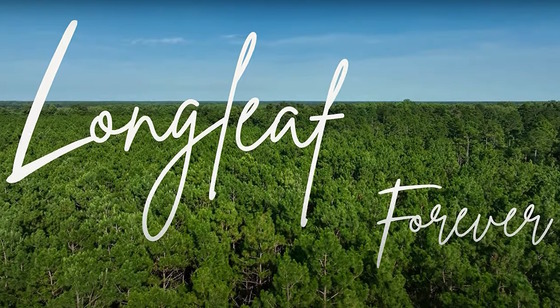 Take a walk on the wild side with “Longleaf Forever,” a compelling documentary that guides viewers through one of Earth’s most biologically diverse ecosystems.
The award-winning film ranges from forester Paul Massey, who has spent his life conserving longleaf pine ecosystems in the Red Hills region, to pine needle basket-maker Nancy Basket and ecology experts including DNR’s Amaad Blades, Shan Cammack and Erin Cork explaining the wildlife native to longleaf forests and the essential role fire plays in these habitats.
DNR partnered with Magic Kumquat Productions and The Longleaf Alliance on “Longleaf Forever,” which debuted last month.
 When Ben Rountree saw a gopher tortoise crawling near the surf on St. Simons Island in May, the south Georgia native knew what it was. But he also knew it was unusual.
“There was a crowd of people watching and some thought it was a sea turtle,” Rountree said, admitting the misidentification caused him to chuckle.
Yet his family has had a condo on St. Simons for some 20 years, the Statesboro pharmacist said, and he'd "never seen a gopher tortoise in the dunes or on the beach.”
Why this tortoise was wet and crawling from damp sand to high ground near The King and Prince Resort will likely remain a mystery. DNR senior wildlife biologist Daniel Sollenberger said possible scenarios vary from uninformed – someone illegally moved the tortoise from its upland habitats to the beach – to unique: The turtle was crossing a waterway upstream and the current swept it out to sea.
Although gopher tortoises are land reptiles, they can float and paddle, and they even sometimes “willingly enter the water,” Sollenberger said.
There are documented instances of other tortoise species traveling by water, if unintentionally. Sollenberger also pointed out that the gopher tortoise’s range is crisscrossed by creeks and rivers.
“Water is a barrier that will limit their dispersal, but occasionally individuals do cross water bodies. Especially if it’s something they can see the other side of. If turtles can see it, they’ll go there.”
Yet he also cautioned that tortoises are “not particularly good swimmers” and they “don’t like going in the water.” Which could help explain why gopher tortoise populations on Georgia barrier islands are scarce, and at least one – on St. Catherines – and possibly all were started by people. Other factors raising the odds against barrier-island gophers are high water tables and hurricanes and tropical storms that can reset new populations.
The St. Simons castaway speaks to a little-known side of Georgia's state reptile. However, Sollenberger suggests that insight comes with a caveat: If a tortoise wants to test the water, let it make that decision.
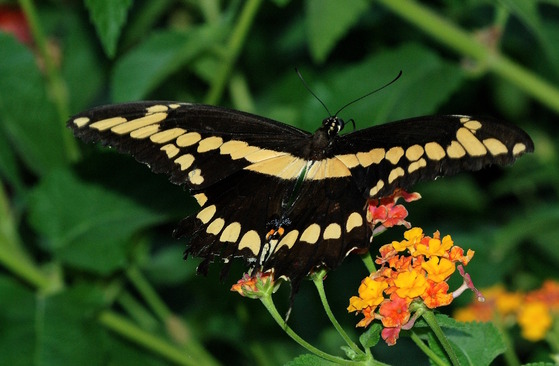 Giant swallowtail (Terry W. Johnson)
By TERRY W. JOHNSON
I have a fascination with the giant swallowtail.
Perhaps this is because its 4.5- to 5.5-inch wingspan earns it the reputation as North America’s largest butterfly. Then again, maybe it’s due to the fact that giant swallowtails are both big and beautiful.
Unfortunately for my yard in middle Georgia, while this gorgeous butterfly ranges across the state, it is far more common in counties south of the Fall Line. My efforts to attract giant swallowtails have centered on providing a continuous supply of nectar plants throughout as much of the growing season as possible.
While this hasn’t proved to be a winning strategy, it has led me to a plant with a history as odd as the giant swallowtail is pleasing to the eye. …
Read Terry’s column for more.
Terry W. Johnson is a retired DNR manager and executive director of TERN, friends group of the Wildlife Conservation Section. Check out past columns and his blog. Permission is required to reprint a column.
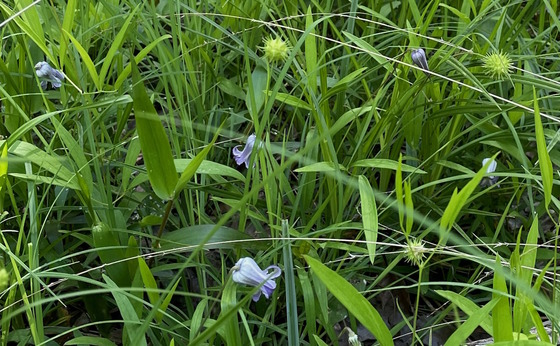 Alabama leatherflower in Floyd County (Carlee Steppe/DNR)
For the first time in Georgia, seed has been collected from endangered Alabama leatherflower. Georgia Plant Conservation Alliance members including DNR, the state Department of Transportation, Berry College and Georgia Highlands College gathered the seed from Clematis socialis last month at the state’s only known natural population. Deer browsing had stymied the leatherflower from fruiting since at least 2005, when the state acquired the Floyd County site. But in work led by DNR botanist Carlee Steppe, fencing was installed last year to protect the plants. Given a break from being browsed, they bore fruit. Atlanta Botanical Garden will use the seed to study how best to grow Alabama leatherflower, part of research to preserve this and 13 other imperiled plant species in the state.
Efforts to expand plant and habitat restoration recently received a hefty boost. The U.S. Fish and Wildlife Service awarded UGA’s State Botanical Garden of Georgia $1.6 million to bolster the Georgia Native Seed Network, which aims to produce “locally adapted seeds and other plant materials across much of the Southeast.”
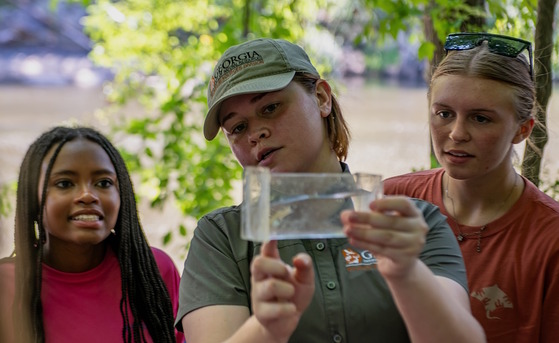 DNR's Jess Rath shows Hutton Junior Fisheries Biology students a mosquitofish (Peter Turcik/AFS)
DNR’s Stream Survey Team helped 23 Hutton Junior Fisheries Biology Program teens explore fish sampling in the Alcovy River. As part of the American Fisheries Society internship, the high-schoolers tried electrofishing, seining and identifying fishes, from snail bullheads to redbreast sunfish.
An almost 10-foot-long smalltooth sawfish was caught and released on the St. Marys River by University of North Florida researchers in July. The endangered sawfish was the first the school’s shark population surveys have documented in northeast Florida and southeast Georgia in 16 years.
 Herding a creche of royal tern chicks on Bird Island; right, a chick being banded (Tim Keyes, Ellie Kania/DNR)
Nearly 660 royal tern chicks were banded on Bird Island in July. The DNR-led roundup joined by partner organizations and volunteers continued monitoring that began with a mass banding at the Brunswick Harbor island in 2019 and was repeated last year. The efforts that have yielded 3,000-plus resightings of banded royal terns – from Florida to Peru – data will help scientists better understand this seabird's natural history. Read Birds Georgia "Field Notes" on the banding.
About that Jonah rattler: DNR has learned that the juvenile eastern diamond-backed rattlesnake eaten and regurgitated alive by an eastern indigo snake in November was seen again three weeks later and apparently OK. Details in our “Down(ed) and Out” blog post.
 Quick hits:
Names in the news: DNR’s Game Management Section has named two new regional supervisors, promoting IB Parnell to lead Region 3 in central Georgia and David Gregory to shepherd Region 1 in northwest Georgia.
WHAT YOU MISSED ...
In the previous Georgia Wild:
- Shedding light on fireflies
- Eagle nesting stays strong
- Wild tegu sightings spike
- Shoddy nest, successful bird
 Bog turtle (DNR)
Bog turtle conservation updates in Georgia, DNR
"Whale Capsizes Fishing Boat off New Hampshire," Associated Press
Sea turtle hatchlings scurry to the surf, DNR
"Humpback Whale Missing Flukes," The Oregonian (Portland, Ore.)
"Camera Collar Footage from Coyotes in Atlanta," UGA Warnell School of Forestry and Natural Resources
State herpetologist Daniel Sollenberger talks snakes, DNR
"MARTA Rail Cars Become Habitat off Georgia Coast," WXIA-TV (ch. 11, Atlanta)
"King Snake Stuck in Landscaping Netting," Sanders Wildlife
(+audio) "How alligator snapping turtles became threatened in Georgia," WABE-FM (90.1, Atlanta)
"Study of inbreeding among right whales reveals encouraging finding," Canadian Broadcasting Corp. Other right whale coverage: "Even minor entanglements limit calving" (Tribune & Georgian, St. Marys), (+video) "Right whale seen off Ireland for first time in 114 years" (The Guardian, London); (+video), "Team frees entangled whale in St. Lawrence" (CTV News, Toronto).
"Georgia sea turtle nesting season hitting high marks," The Brunswick News
"Exploring a family legacy: Okefenokee's Chesser Island," U.S. Fish and Wildlife Service
"Eagles ‘nesting strong’ across Georgia in latest survey," WSB-TV (ch. 2, Atlanta). Also: Georgia Public Broadcasting, Georgia Recorder, WUGA-FM.
"DNR initiative offers accessibility to Georgians with disabilities," The Albany Herald and others
"Habitat loss due to urbanization threatens fireflies," The Augusta Chronicle
"Young black bear in Cobb safely relocated," The Atlanta Journal-Constitution
"How international effort is keeping North America free of deadly amphibian disease," Mongabay
(+video) "Blue crab sightings cause concern in coastal Georgia," WTOC-TV (ch. 11, Savannah)
"Burke 4-H wins at state wildlife judging contest," The True Citizen (Waynesboro)
"Birds get wanderlust this time of year," The Atlanta Journal-Constitution
"Crisp County High ag department awarded wildlife, conservation teaching materials," Cordele Dispatch
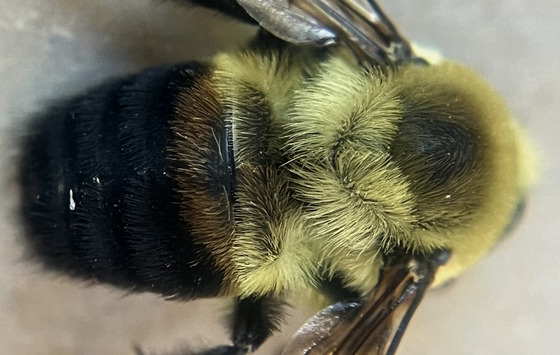 In case you’re wondering, this is the back of a brown-belted bumble bee. This bee and others were netted during a DNR-led survey this summer at Foster Brady Farm near Monroe. The bees were placed in vials, followed by 20 minutes in a cooler to relax them. The goal then: identify the species and sex. This was done by spreading the wings and examining the face, head, thorax and tergites on the abdomen. (Tergites are part of the microskeleton that subdivides the dorsal section of the bee’s body.) Based on the belt of brown hair on the second tergite and other distinguishing characteristics, the bee pictured was ID'd as a female Bombus griseocollis and later released. Brown-belted bumble bees are native to much of the U.S. and parts of Canada, and common throughout, a welcomed change to the narrative of declining populations for many native pollinators.
- Caitlin Lyons
CREDIT
Masthead: gopher tortoise (Mark Krist)
Top
|